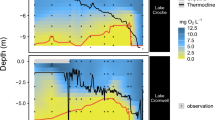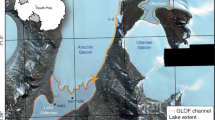Abstract
Riverine organic matter supports of the order of one-fifth of estuarine metabolism1. Coastal ecosystems are therefore sensitive to alteration of both the quantity and lability of terrigenous dissolved organic matter (DOM) delivered by rivers. The lability of DOM is thought to vary with age, with younger, relatively unaltered organic matter being more easily metabolized by aquatic heterotrophs than older, heavily modified material2,3,4. This view is developed exclusively from work in watersheds where terrestrial plant and soil sources dominate streamwater DOM. Here we characterize streamwater DOM from 11 coastal watersheds on the Gulf of Alaska that vary widely in glacier coverage (0–64 per cent). In contrast to non-glacial rivers, we find that the bioavailability of DOM to marine microorganisms is significantly correlated with increasing 14C age. Moreover, the most heavily glaciated watersheds are the source of the oldest (∼4 kyr 14C age) and most labile (66 per cent bioavailable) DOM. These glacial watersheds have extreme runoff rates, in part because they are subject to some of the highest rates of glacier volume loss on Earth5. We estimate the cumulative flux of dissolved organic carbon derived from glaciers contributing runoff to the Gulf of Alaska at 0.13 ± 0.01 Tg yr-1 (1 Tg = 1012 g), of which ∼0.10 Tg is highly labile. This indicates that glacial runoff is a quantitatively important source of labile reduced carbon to marine ecosystems. Moreover, because glaciers and ice sheets represent the second largest reservoir of water in the global hydrologic system, our findings indicate that climatically driven changes in glacier volume could alter the age, quantity and reactivity of DOM entering coastal oceans.
This is a preview of subscription content, access via your institution
Access options
Subscribe to this journal
Receive 51 print issues and online access
$199.00 per year
only $3.90 per issue
Buy this article
- Purchase on Springer Link
- Instant access to full article PDF
Prices may be subject to local taxes which are calculated during checkout


Similar content being viewed by others
References
Smith, S. V. & Hollibaugh, J. T. Coastal metabolism and the oceanic organic carbon balance. Rev. Geophys. 31, 75–89 (1993)
Mayorga, E. et al. Young organic matter as a source of carbon dioxide outgassing from Amazonian rivers. Nature 436, 538–541 (2005)
Raymond, P. A. & Bauer, J. E. Riverine export of aged terrestrial organic matter to the North Atlantic Ocean. Nature 409, 497–500 (2001)
Raymond, P. A. et al. Flux and age of dissolved organic carbon exported to the Arctic Ocean: a carbon isotopic study of the five largest arctic rivers. Glob. Biogeochem. Cycles 21 GB4011 10.1029/2007GB002934 (2007)
Arendt, A. A., Echelmeyer, K. A., Harrison, W. D., Lingle, C. S. & Valentine, V. B. Rapid wastage of Alaska glaciers and their contribution to rising sea level. Science 297, 382–386 (2002)
Rabalais, N. N., Turner, R. E. & Wiseman, W. J. Gulf of Mexico hypoxia, aka “The dead zone”. Annu. Rev. Ecol. Syst. 33, 235–263 (2002)
Sondergaard, M., Stedmon, C. A. & Borch, N. H. Fate of terrigenous dissolved organic matter in estuaries: aggregation and bioavailability. Ophelia 57, 161–176 (2003)
Skidmore, M. L., Foght, J. M. & Sharp, M. J. Microbial life beneath a high arctic glacier. Appl. Environ. Microbiol. 66, 3124–3220 (2000)
Ludwig, W., Probst, J. L. & Kempe, S. Predicting the oceanic input of organic carbon by continental erosion. Glob. Biogeochem. Cycles 10, 23–41 (1996)
Royer, T. C. & Grosch, C. E. Ocean warming and freshening in the northern Gulf of Alaska. Geophys. Res. Lett. 33 L16605 10.1029/2006GL026767 (2006)
Hood, E. & Scott, D. Riverine organic matter and nutrients in southeast Alaska affected by glacial coverage. Nature Geosci. 1, 583–587 (2008)
Barker, J. D., Sharp, M. J., Fitzsimons, S. J. & Turner, R. J. Abundance and dynamics of dissolved organic carbon in glacier systems. J. Arct. Antarct. Alpine Res. 38, 163–172 (2006)
Hood, E. & Berner, L. The effect of changing glacial coverage on the physical and biogeochemical properties of coastal streams in southeastern Alaska. J. Geophys. Res. 114 G03001 10.1029/2009JG000971 (2009)
Weishaar, J. L., Aiken, G. R., Bergamaschi, B. A., Fram, M. S. & Fujil, R. Evaluation of specific ultraviolet absorbance as an indicator of the chemical composition and reactivity of dissolved organic carbon. Environ. Sci. Technol. 37, 4702–4708 (2003)
Schiff, S. L., Aravena, R., Trumbore, S. E. & Hinton, M. J. Export of DOC from forested catchments on the Precambrian Shield of Central Ontario: clues from 13C and 14C. Biogeochemistry 36, 43–65 (1997)
McKnight, D. M., Hood, E. & Klapper, L. in Aquatic Ecosystems: Interactivity of Dissolved Organic Matter (eds Findlay, S. E. G. & Sinsabaugh, R. L.) Ch. 3 71–96 (Academic, 2003)
Opsahl, S. & Benner, R. Distribution and cycling of terrigenous dissolved organic matter in the ocean. Nature 386, 480–482 (1997)
Hernes, P. J. & Benner, R. Photochemical and microbial degradation of dissolved lignin phenols: implications for the fate of terrigenous dissolved organic matter in marine environments. J. Geophys. Res. 108 3291 10.1029/2002JC001421 (2003)
Anesio, A. M., Hodson, A. J., Fritz, A., Psenner, R. & Sattler, B. High microbial activity on glaciers: importance to the global carbon cycle. Glob. Change Biol. 15, 955–960 (2008)
Bardgett, R. D. et al. Heterotrophic microbial communities use ancient carbon following glacial retreat. Biol. Lett. 3, 487–490 (2007)
McKnight, D. M., Andrews, E. D., Spaulding, S. A. & Aiken, G. R. Aquatic fulvic acids in algal-rich Antarctic ponds. Limnol. Oceanogr. 39, 1972–1979 (1994)
Hodson, A. et al. Glacial ecosystems. Ecol. Monogr. 78, 41–67 (2008)
Deevey, E. S. & Flint, R. F. Postglacial hypsithermal interval. Science 125, 182–184 (1957)
Druffel, E. R. M. & Bauer, J. E. Radiocarbon distributions in Southern Ocean dissolved and particulate organic matter. Geophys. Res. Lett. 27, 1495–1498 (2000)
Holmes, R. M. et al. Lability of DOC transported by Alaskan rivers to the Arctic Ocean. Geophys. Res. Lett. 35 L03402 10.1029/2007GL032837 (2008)
Spencer, R. G. M. et al. Utilizing chromophoric dissolved organic matter measurements to derive export and reactivity of dissolved organic carbon exported to the Arctic Ocean: a case study of the Yukon River. Geophys. Res. Lett. 36 L060401 10.1029/2008GL036831 (2009)
Opsahl, S., Benner, R. & Amon, R. Major flux of terrigenous dissolved organic matter through the Arctic Ocean. Limnol. Oceanogr. 44, 2017–2023 (1999)
Larsen, C. F., Motyka, R. J., Arendt, A. A., Echelmeyer, K. A. & Geissler, P. E. Glacier changes in southeast Alaska and northwest British Columbia and contribution to sea level rise. J. Geophys. Res. 112 F01007 10.1029/2006JF000586 (2007)
Neal, E. G., Walter, M. T. & Coffeen, C. Linking the Pacific Decadal Oscillation to seasonal stream discharge patterns in southeast Alaska. J. Hydrol. 263, 188–197 (2002)
Meier, M. F. et al. Glaciers dominate eustatic sea-level rise in the 21st century. Science 317, 1064–1067 (2007)
Chin-Leo, G. & Benner, R. Enhanced bacterioplankton production and respiration at intermediate salinities in the Mississippi River plume. Mar. Ecol. Prog. Ser. 87, 87–103 (1992)
Hanna, E. et al. Runoff and mass balance of the Greenland ice sheet: 1958–2003. J. Geophys. Res. D 110 D13108 10.1029/2004JD005641 (2005)
Fellman, J. B., Hood, E., D'Amore, D. V. & Boone, R. D. Fluorescence characteristics and biodegradability of dissolved organic matter in forest and wetland soils from coastal temperate watersheds in southeast Alaska. Biogeochemistry 88, 169–184 (2008)
Simpson, J. J., Hufford, G. L., Daly, C., Berg, J. S. & Fleming, M. D. Comparing maps of mean monthly surface temperature and precipitation for Alaska and adjacent areas of Canada produced by two different methods. Arctic 58, 137–161 (2005)
Acknowledgements
E. Neal and K. Smikrud contributed to the GOA glacier water flux estimates and K. Smikrud also provided Fig. 1. A. Arendt provided data on glacial wastage. We thank X. Xu at the KCCAMS facility for 14C analyses, and R. Dyda and B. Holmes at UC Davis for assistance with lignin and 13C-DOC analyses, respectively. Funding came from the US National Science Foundation (EAR-0838587), a University of Alaska Seed Grant (to E.H.) and the USDA Forest Service, Pacific Northwest Research Station. The use of trade or firm names in this publication does not imply endorsement by the US Department of Agriculture.
Author Contributions E.H., J.F., R.G.M.S. and D.S. designed the research. J.F. performed the fieldwork and J.F., R.G.M.S. and E.H. performed laboratory analyses. P.J.H., R.E. and D.D. supported analyses and aided data interpretation. E.H. wrote the paper with substantial contributions from J.F., R.G.M.S. and P.J.H. All authors discussed the results and commented on the manuscript.
Author information
Authors and Affiliations
Corresponding author
PowerPoint slides
Rights and permissions
About this article
Cite this article
Hood, E., Fellman, J., Spencer, R. et al. Glaciers as a source of ancient and labile organic matter to the marine environment. Nature 462, 1044–1047 (2009). https://doi.org/10.1038/nature08580
Received:
Accepted:
Issue Date:
DOI: https://doi.org/10.1038/nature08580
This article is cited by
-
Marine and Not Terrestrial Resources Support Nearshore Food Webs Across a Gradient of Glacial Watersheds in the Northern Gulf of Alaska
Estuaries and Coasts (2024)
-
A review of physicochemical properties of dissolved organic carbon and its impact over mountain glaciers
Journal of Mountain Science (2024)
-
Fossil organic carbon utilization in marine Arctic fjord sediments by subsurface micro-organisms
Nature Geoscience (2023)
-
Glacier retreat alters downstream fjord ecosystem structure and function in Greenland
Nature Geoscience (2023)
-
Pre-aged terrigenous organic carbon biases ocean ventilation-age reconstructions in the North Atlantic
Nature Communications (2023)
Comments
By submitting a comment you agree to abide by our Terms and Community Guidelines. If you find something abusive or that does not comply with our terms or guidelines please flag it as inappropriate.



